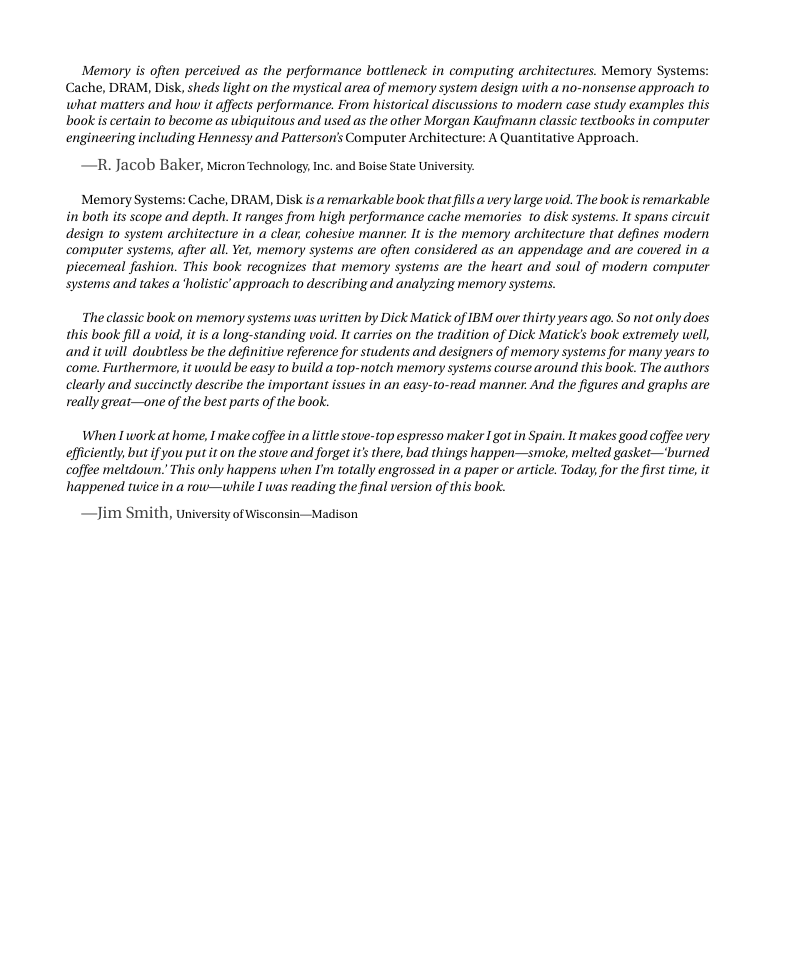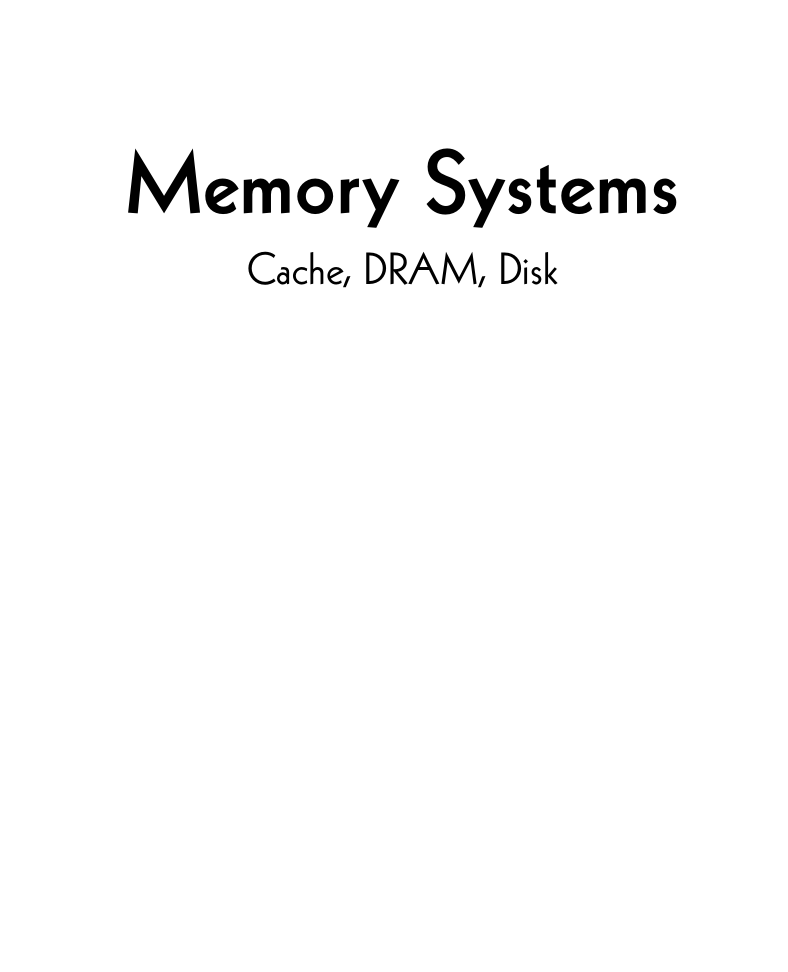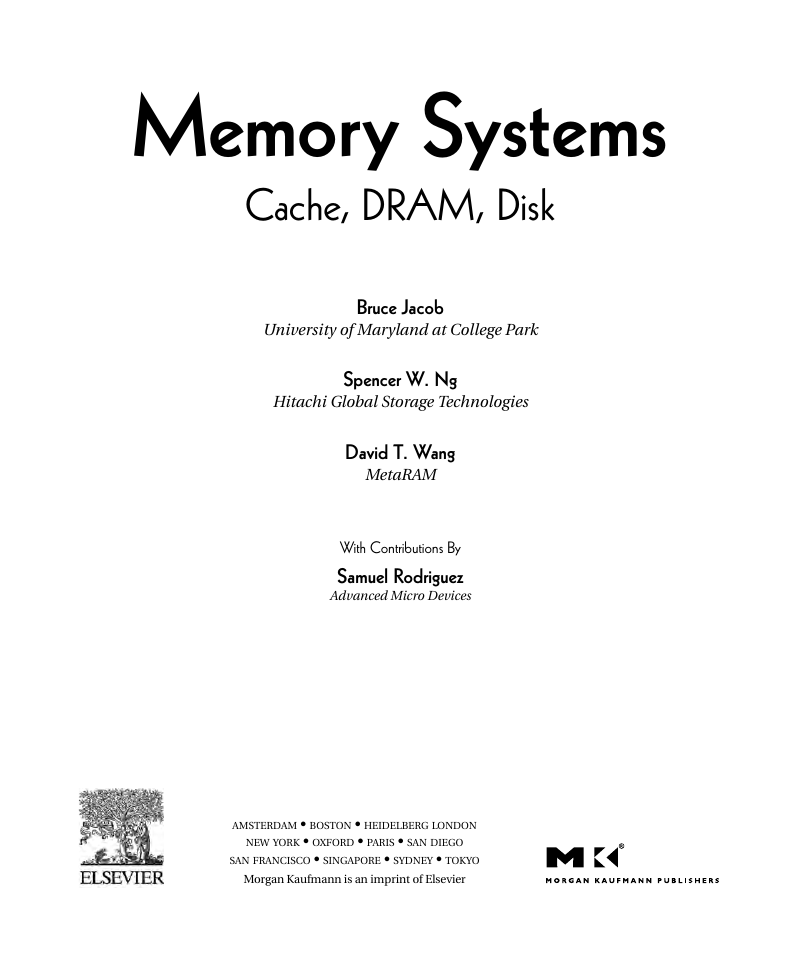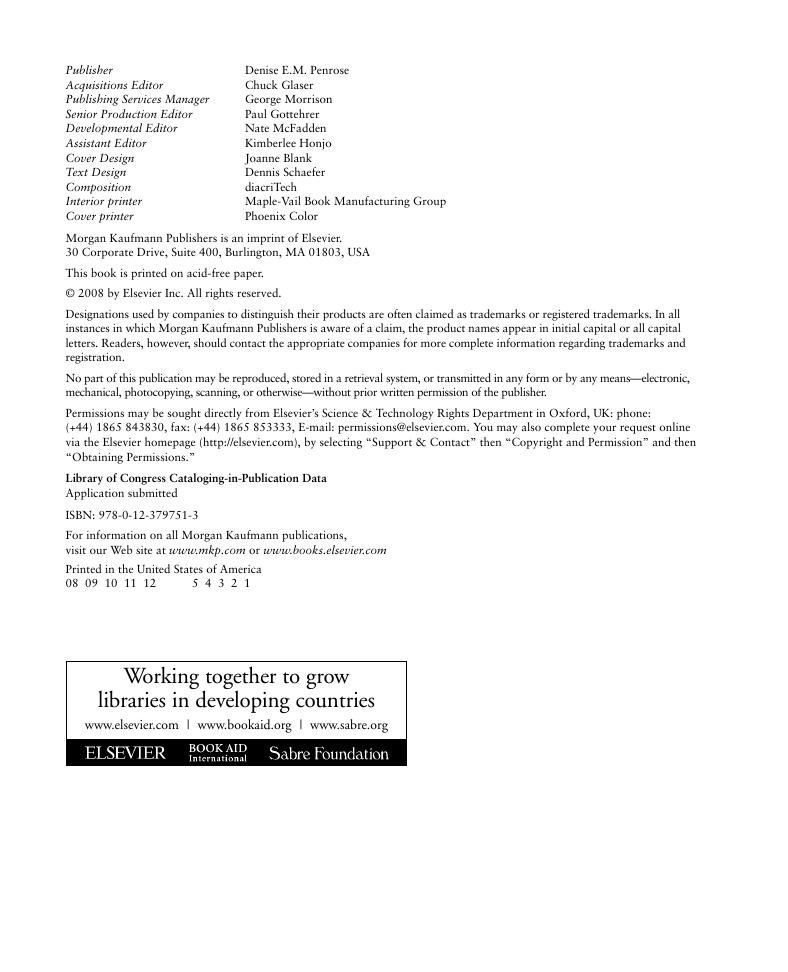In Praise of Memory Systems: Cache, DRAM, Disk
Memory Systems Cache, DRAM, Disk
Copyright Page
Contents
Preface
Overview. On Memory Systems and Their Design
Ov.1 Memory Systems
Ov.2 Four Anecdotes on Modular Design
Ov.2.1 Anecdote I: Systemic Behaviors Exist
Ov.3 Cross-Cutting Issues
Ov.3.1 Cost/Performance Analysis
Ov.3.2 Power and Energy
Ov.4 An Example Holistic Analysis
Ov.5 What to Expect
Part I. Cache
Chapter 1. An Overview of Cache Principles
1.1 Caches, ‘Caches,’ and “Caches”
1.2 Locality Principles
1.3 What to Cache, Where to Put It, and How to Maintain It
1.4 Insights and Optimizations
Chapter 2. Logical Organization
2.1 Logical Organization: A Taxonomy
2.2 Transparently Addressed Caches
2.3 Non-Transparently Addressed Caches
2.4 Virtual Addressing and Protection
2.5 Distributed and Partitioned Caches
2.6 Case Studies
Chapter 3. Management of Cache Contents
3.1 Case Studies: On-Line Heuristics
3.2 Case Studies: Off-Line Heuristics
3.3 Case Studies: Combined Approaches
3.4 Discussions
3.5 Building a Content-Management
Chapter 4. Management of Cache Consistency
4.1 Consistency with Backing Store
4.2 Consistency with Self
4.3 Consistency with Other Clients
Chapter 5. Implementation Issues
5.1 Overview
5.2 SRAM Implementation
5.3 Advanced SRAM Topics
5.4 Cache Implementation
Chapter 6. Cache Case Studies
6.1 Logical Organization
6.2 Pipeline Interface
6.3 Case Studies of Detailed Itanium-2 Circuits
Part II. DRAM
Chapter 7. Overview of DRAMs
7.1 DRAM Basics: Internals, Operation
7.2 Evolution of the DRAM Architecture
7.3 Modern-Day DRAM Standards
7.4 Fully Buffered DIMM: A Compromise of Sorts
7.5 Issues in DRAM Systems, Briefly
Chapter 8. DRAM Device Organization: Basic Circuits and Architecture
8.1 DRAM Device Organization
8.2 DRAM Storage Cells
8.3 RAM Array Structures
8.4 Differential Sense Amplifier
8.5 Decoders and Redundancy
8.6 DRAM Device Control Logic
8.7 DRAM Device Confi guration
8.8 Data I/O
8.9 DRAM Device Packaging
8.10 DRAM Process Technology and Process Scaling Considerations
Chapter 9. DRAM System Signaling and Timing
9.1 Signaling System
9.2 Transmission Lines on PCBs
9.3 Termination
9.4 Signaling
9.5 Timing Synchronization
9.6 Selected DRAM Signaling and Timing Issues
9.7 Summary
Chapter 10. DRAM Memory System Organization
10.1 Conventional Memory System
10.2 Basic Nomenclature
10.3 Memory Modules
10.4 Memory System Topology
10.5 Summary
Chapter 11. Basic DRAM Memory-Access Protocol
11.1 Basic DRAM Commands
11.2 DRAM Command Interactions
11.3 Additional Constraints
11.4 Command Timing Summary
11.5 Summary
Chapter 12. Evolutionary Developments of DRAM Device Architecture
12.1 DRAM Device Families
12.2 Historical-Commodity DRAM Devices
12.3 Modern-Commodity DRAM Devices
12.4 High Bandwidth Path
12.5 Low Latency
12.6 Interesting Alternatives
Chapter 13. DRAM Memory Controller
13.1 DRAM Controller Architecture
13.2 Row-Buffer-Management Policy
13.3 Address Mapping (Translation)
13.4 Performance Optimization
13.5 Summary
Chapter 14. The Fully Buffered DIMM Memory System
14.1 Introduction
14.2 Architecture
14.3 Signaling and Timing
14.4 Access Protocol
14.5 The Advanced Memory Buffer
14.6 Reliability, Availability, and Serviceability
14.7 FB-DIMM Performance Characteristics
14.8 Perspective
Chapter 15. Memory System Design Analysis
15.1 Overview
15.2 Workload Characteristics
15.3 The RAD Analytical Framework
15.4 Simulation-Based Analysis
15.5 A Latency-Oriented Study
15.6 Concluding Remarks
Part III. Disk
Chapter 16. Overview of Disks
16.1 History of Disk Drives
16.2 Principles of Hard Disk Drives
16.3 Classifications of Disk Drives
16.4 Disk Performance Overview
16.5 Future Directions in Disks
Chapter 17. The Physical Layer
17.1 Magnetic Recording
17.2 Mechanical and Magnetic Components
17.3 Electronics
Chapter 18. The Data Layer
18.1 Disk Blocks and Sectors
18.2 Tracks and Cylinders
18.3 Address Mapping
18.4 Zoned-Bit Recording
18.5 Servo
18.6 Sector ID and No-ID Formatting
18.7 Capacity
18.8 Data Rate
18.9 Defect Management
Chapter 19. Performance Issues and Design Trade-Offs
19.1 Anatomy of an I/O
19.2 Some Basic Principles
19.3 BPI vs. TPI
19.4 Effect of Drive Capacity
19.5 Concentric Tracks vs. Spiral Track
19.6 Average Seek
Chapter 20. Drive Interface
20.1 Overview of Interfaces
20.2 ATA
20.3 Serial ATA
20.4 SCSI
20.5 Serial SCSI
20.6 Fibre Channel
20.7 Cost, Performance, and Reliability
Chapter 21. Operational Performance Improvement
21.1 Latency Reduction Techniques
21.2 Command Queueing andScheduling
21.3 Reorganizing Data on the Disk
21.4 Handling Writes
21.5 Data Compression
Chapter 22. The Cache Layer
22.1 Disk Cache
22.2 Cache Organizations
22.3 Caching Algorithms
Chapter 23. Performance Testing
23.1 Test and Measurement
23.2 Basic Tests
23.3 Benchmark Tests
23.4 Drive Parameters Tests
Chapter 24. Storage Subsystems
24.1 Data Striping
24.2 Data Mirroring
24.3 RAID
24.4 SAN
24.5 NAS
24.6 iSCSI
Chapter 25. Advanced Topics
25.1 Perpendicular Recording
25.2 Patterned Media
25.3 Thermally Assisted Recording
25.4 Dual Stage Actuator
25.5 Adaptive Formatting
25.6 Hybrid Disk Drive
25.7 Object-Based Storage
Chapter 26. Case Study
26.1 The Mechanical Components
26.2 Electronics
26.3 Data Layout
26.4 Interface
26.5 Cache
26.6 Performance Testing
Part IV. Cross-Cutting Issues
Chapter 27. The Case for Holistic Design
27.1 Anecdotes, Revisited
27.2 Perspective
Chapter 28. Analysis of Cost and Performance
28.1 Combining Cost and Performance
28.2 Pareto Optimality
28.3 Taking Sampled Averages Correctly
28.4 Metrics for Computer Performance
28.5 Analytical Modeling and the Miss-Rate Function
Chapter 29. Power and Leakage
29.1 Sources of Leakage in CMOS Devices
29.2 A Closer Look at Subthreshold Leakage
29.3 CACTI and Energy/Power Breakdown of Pipelined Nanometer Caches
Chapter 30. Memory Errors and Error Correction
30.1 Types and Causes of Failures
30.2 Soft Error Rates and Trends
30.3 Error Detection and Correction
30.4 Reliability of Non-DRAM Systems
30.5 Space Shuttle Memory System
Chapter 31. Virtual Memory
31.1 A Virtual Memory Primer
31.2 Implementing Virtual Memory
References
Index
















 2023年江西萍乡中考道德与法治真题及答案.doc
2023年江西萍乡中考道德与法治真题及答案.doc 2012年重庆南川中考生物真题及答案.doc
2012年重庆南川中考生物真题及答案.doc 2013年江西师范大学地理学综合及文艺理论基础考研真题.doc
2013年江西师范大学地理学综合及文艺理论基础考研真题.doc 2020年四川甘孜小升初语文真题及答案I卷.doc
2020年四川甘孜小升初语文真题及答案I卷.doc 2020年注册岩土工程师专业基础考试真题及答案.doc
2020年注册岩土工程师专业基础考试真题及答案.doc 2023-2024学年福建省厦门市九年级上学期数学月考试题及答案.doc
2023-2024学年福建省厦门市九年级上学期数学月考试题及答案.doc 2021-2022学年辽宁省沈阳市大东区九年级上学期语文期末试题及答案.doc
2021-2022学年辽宁省沈阳市大东区九年级上学期语文期末试题及答案.doc 2022-2023学年北京东城区初三第一学期物理期末试卷及答案.doc
2022-2023学年北京东城区初三第一学期物理期末试卷及答案.doc 2018上半年江西教师资格初中地理学科知识与教学能力真题及答案.doc
2018上半年江西教师资格初中地理学科知识与教学能力真题及答案.doc 2012年河北国家公务员申论考试真题及答案-省级.doc
2012年河北国家公务员申论考试真题及答案-省级.doc 2020-2021学年江苏省扬州市江都区邵樊片九年级上学期数学第一次质量检测试题及答案.doc
2020-2021学年江苏省扬州市江都区邵樊片九年级上学期数学第一次质量检测试题及答案.doc 2022下半年黑龙江教师资格证中学综合素质真题及答案.doc
2022下半年黑龙江教师资格证中学综合素质真题及答案.doc